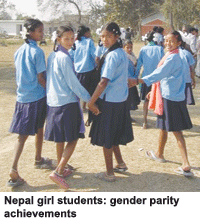Nepal is investing US$15 million (Rs.67.5 crore) to build separate toilets for female public school students in an effort to reduce the number of girls missing classes or dropping out because of the lack of private changing facilities during menstrual cycles, according to a government spokesperson.
The government believes that apart from providing more privacy, the new toilets will also boost sanitation and health generally. The scheme is due to start in April, say education officials of this landlocked mountain kingdom recently transformed into a parliamentary democracy (pop. 29 million). “This is certainly great news for Nepali girls because the lack of separate toilets has always been a grossly neglected issue,” says education specialist Helen Sherpa of World Education, a transnational NGO.
But Emily Oster, one of the principal authors of a study on the impact of menstruation on school attendance in Nepal, is not convinced. “As far as we know, there is no quantitative evidence of the impact of separate toilets on girls’ schooling… what we can say based on our paper is that menstruation has only a very tiny impact on schooling for girls.”
 The 2010 study entitled Menstruation, Sanitary Products and School Attendance: Evidence from a Randomized Evaluation by researchers from Michigan and Chicago universities — based on a survey of 198 schoolgirls — concluded through randomized trials (comparing girls with and without amenities), that there is little relationship between menstruation and girls school attendance. Frequently used in scientific research, randomized trials are increasingly used to test the efficacy of development interventions.
The 2010 study entitled Menstruation, Sanitary Products and School Attendance: Evidence from a Randomized Evaluation by researchers from Michigan and Chicago universities — based on a survey of 198 schoolgirls — concluded through randomized trials (comparing girls with and without amenities), that there is little relationship between menstruation and girls school attendance. Frequently used in scientific research, randomized trials are increasingly used to test the efficacy of development interventions.
According to Oster, while some studies have shown girls in schools with separate toilets are more likely to attend, it is difficult to establish causality. She says distributing improved sanitary products to menstruating girls doesn’t have a significant impact on girls’ schooling either. “This suggests the claims made by NGOs, the UN, the World Bank, etc overstate the importance of sanitary products,” adds Oster.
“Girl students in Nepal have bigger problems than menstruation affecting their studies or class attendance, like helping their parents in household and farming chores,” says Bed Prasad Kaju, headmaster of Sanjewani Model High School, a state school in Dhulikhel municipality, 20 km north of Kathmandu. Although his school doesn’t have enough toilets, more than 50 percent of his 1,100 students are girls. “They regularly attend school and their achievements match those of the boys,” he says.
Nevertheless given that the government’s aim is to boost adult literacy, which is currently 44.2 percent for women and 67.7 percent for men, building separate toilets for girls is high on the education department’s list of priorities. “We are making this our top priority issue this year,” says Lekhnath Poudel, a senior official of the ministry of education.
The scheme plans to install separate toilets for girls in 5,500 secondary schools by the end of 2011, and in all 28,000 state secondary schools by 2014-15, says Khagaraj Baral, director of planning in the department of education.
(Excerpted and adapted from www.irinnews.org)